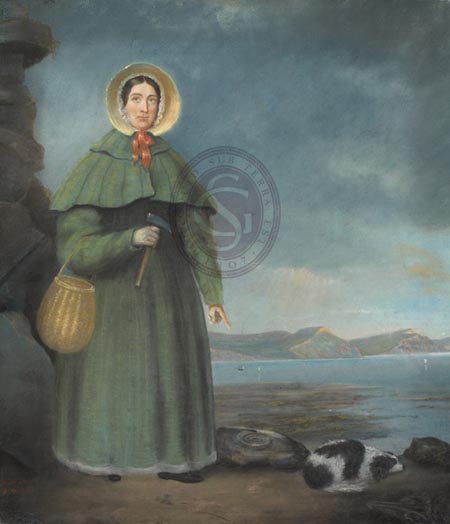Portrait of Mary Anning (1799-1847)
 |
|
Pastel portrait of Mary Anning by Benjamin John Merifield Donne, 1850. (GSL/POR/1)
Provenance: Presented to the Society by William Willoughby Cole, 3rd Earl of Enniskillen, 1875.
|
Probably the most famous female geologist, Mary Anning was born in Lyme Regis. Her father Richard Anning was a cabinet-maker and carpenter, but was also known locally as a fossil collector, selling his finds to tourists who flocked to the seaside resort at the end of the 18th century.
The knowledge was passed down to Mary and her brother Joseph (1796-1849). Their first major find was an Ichthyosaur which they discovered in two sections in 1811 and 1812. Fragments of this Jurassic marine reptile had been found before, but this was the first to come to the attention of gentlemen scientists in London.
Mary's second major discovery was another marine reptile, a nine feet long animal with a small head like a turtle but very long neck. It was described at a Geological Society meeting in 1824 and was recognised as being a virtually complete example of a plesiosaur. The find not only established the Anning family credentials as fossil dealers, but Mary became a draw in her own right. Tourists came to Lyme to not only buy fossils but to see her. Her other major fossil discoveries included the flying reptile Pterodactylus, the fish Squaloraja and even coprolites (fossil faeces).

|
| Duria Antiquior by Henry Thomas De la Beche (1830). This print, sold in aid of Mary Anning, shows Jurassic Dorset populated by the creatures and plants which Anning discovered. |
Mary was never a Fellow of the Society. However, in recognition of her achievements, she received three different annuities and subscriptions raised by the scientific community in the last decade of her life. She died at the age of 47 years of breast cancer.
In the portrait, Mary is seen standing in front of the headland Golden Cap, the highest point on the south coast of England. Her faithful dog Tray is seen sleeping at her feet.
An exhibition about Mary and her connections with Fellows of the Geological Society can be found on our Collection Highlights pages.